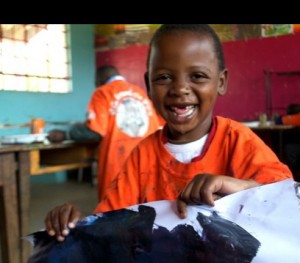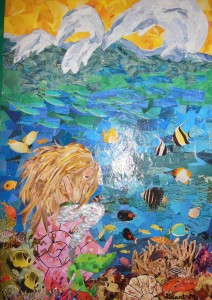
When I was 13, the Beastie Boys had a radio hit that I loved, “Fight for your Right to Party.” I want to know, seriously, is there a universal human right to party? When society decides to celebrate, who’s getting an invite? And who’s being excluded?
 Mardi Gras is the
definition of an open-access party. It’s
not one parade on one day. Mardi Gras is
a month-long public celebration. We have
68 parades, called “krewes”, each with it’s own theme and history. Thousands are present, all ages, all
backgrounds, all partying more or less together.
Mardi Gras is the
definition of an open-access party. It’s
not one parade on one day. Mardi Gras is
a month-long public celebration. We have
68 parades, called “krewes”, each with it’s own theme and history. Thousands are present, all ages, all
backgrounds, all partying more or less together.
The beads are a real thing, the flashing not so much.
This is my friend, Jhett, celebrating Mardi Gras, and fully exercising his right to party. Jhett is about the age I was when I was
listening to the Beastie Boys. Jhett
is marching for the first time in Chewbacchus, a sci-fi themed parade with 800
costumed marchers. Members of this krewe
make their own floats and costumes. It’s
all DIY, irreverent and very, very funky.
As you can see, Jhett likes drumming. He also
likes animation, composes electronic music, sketching and reading. He’s artistically gifted, academically advanced,
eloquent, creative and very, very funny.
Jhett also jumps up and waves his hands when he gets
excited. He often speaks way too
loudly. A routine annoyance will often
make him explode with frustration. He dislikes
most flavors and textures, and subsists on soynut-butter crackers, waffles and
poptarts. He is sensitive to smells and
textures. He sometimes has trouble
connecting socially with peers.
As you may have guessed, Jhett has autism.
 Autism is, essentially, a different way the brain can be “wired”. People with autism
perceive the world differently through their senses, and they to think and express
themselves differently.
Autism is, essentially, a different way the brain can be “wired”. People with autism
perceive the world differently through their senses, and they to think and express
themselves differently.
Above all, autism is characterized by diversity. Autism is characterized by supreme hypersensitivity
in some areas, a great lack of sensitivity in others. A great strength here, a great deceit
there. And each of these qualities
exists independently of the others.
Individuals with autism may have any one of he above symptoms in
strengths in any degree and in any combination.
The way we tend to picture autism doesn't necessarily reflect the diversity and breadth of the spectrum.
Autism is not a binary.
It isn’t even a linear spectrum.
The diversity of the autistic spectrum is multi-directional, and might be best represented as an entire, three dimensional field of potential profiles.
There’s no one profile for autism. So how do you accommodate autism?
 For the answer, let’s go back to Jhett. Here we find him drumming away, well into the third hour of the parade, having just marched 3 miles. And all while carrying a heady drum and cymbals.
For the answer, let’s go back to Jhett. Here we find him drumming away, well into the third hour of the parade, having just marched 3 miles. And all while carrying a heady drum and cymbals. People in the crowd are yelling, smoking, waving lightsabers…
We know about Jhett’s sensitivities. How is Jhett keeping it together? How are the autism and the party coexisting here?
The simple answer is practice, practice, practice… and
accommodation.
My nonprofit, NOLArts Learning Center, prepared a group of teens with autism for nine weeks to get them ready for this event.
My nonprofit, NOLArts Learning Center, prepared a group of teens with autism for nine weeks to get them ready for this event.
 So how did we get our krewe party-ready? Most of those nine weeks were spent doing
what every Chewbacchus parader does- making costumes and props. Of course, our group had a variety of
abilities and learning styles. So every task was broken down into
very bite-sized pieces and presented in different ways- visually, verbally,
hands-on. And we gave plenty of support
where it was needed, with prompts and redirection.
So how did we get our krewe party-ready? Most of those nine weeks were spent doing
what every Chewbacchus parader does- making costumes and props. Of course, our group had a variety of
abilities and learning styles. So every task was broken down into
very bite-sized pieces and presented in different ways- visually, verbally,
hands-on. And we gave plenty of support
where it was needed, with prompts and redirection.
Novelty and chages to routine are usually tough for those
with autism, so we had to make this We spent hours rehearsing, becoming
familiar with the expectations and environment and building a social
rapport. And on the night of the event,
we had some accommodations like noise-canceling headphones and soft, flexible drum
straps.
We chose Chewbacchus as our entry point because of the
atmosphere of acceptance and the celebration of eccentricity. To quote another song, a New Orleans brass
standard, here you get to “Do Whatcha Wanna”.
Now, keep in mind that what we did is not limited to
Chewbacchus, or even Mardi Gras. These practices and principles apply to all sorts of
public events: political rallies, concerts, performances, religious functions,
street fairs.
So this is all very fun, but what is the impact? Why does it matter?
Our participation in the Chewbacchus Mardi Gras parade matters for one powerful reason: autistic people need to participate in public life and culture.
People with autism need to be ready to be active citizens and cultural participants. Families of autistic people need to prepare them to do this. Event organizers need to consider their needs in planning and meet reasonable accommodation requests.
What about YOU, the audience? The rest of the crowd at that parade or concert or exhibit? What do you need to do?
Everyone wants to enjoy a parade. Everyone wants to feel comfortable, to feel
welcome.
 You need to provide the acceptance. This person in the audience needs to
breastfeed? OK. This person in the audience needs to bring a
guide dog? OK. This person in the audience needs to hop
around and wave his hands? OK. No problem.
You need to provide the acceptance. This person in the audience needs to
breastfeed? OK. This person in the audience needs to bring a
guide dog? OK. This person in the audience needs to hop
around and wave his hands? OK. No problem.
Your acceptance is the party invitation. Parents who feel welcome will bring their
autistic kids. Autistic kids who feel
welcome will show up. And continue to
show up in the community throughout their lives.
Everyone deserves a seat at the table. And when we celebrate, everyone deserves to
swing from the chandelier.













